Abstract
1 Previous studies of propranolol disposition in renal failure have been conflicting. 2 Using simultaneous administration of [3H]-propranolol intravenously and unlabelled propranolol orally the principal determinants of drug distribution were calculated in normals, patients with severe renal impairment (creatinine clearance 14.5 +/- 2.8 ml/min) but not on haemodialysis and patients on haemodialysis (creatinine clearance less than 5 ml/min). 3 The effect of haemodialysis on propranolol binding and free fraction was also examined. The percentage of propranolol unbound rose from 7.1% to 9.9%. (P less than 0.001) 20 min following heparinization and beginning haemodialysis. This was accompanied by a large rise in free fatty acids from 0.567 +/- 0.059 to 3.326 +/- 0.691 mumol/ml (P less than 0.005). 4 The blood to plasma concentration ratios of propranolol were significantly higher in patients with renal failure (P less than 0.02) and on haemodialysis (P less than 0.001) and were significantly negatively correlated (P less than 0.001) with the haematocrit. 5 Although the half-life propranolol was significantly shortened in the patients with renal failure (P less than 0.02), there was no change in the apparent liver blood flow, extraction ratio or the principal determinants of steady-state drug concentrations in blood namely oral and intravenous clearance from blood. 6 There is, therefore, no pharmacokinetic basis to adjust the dosage of propranolol in patients with renal failure.
Full text
PDF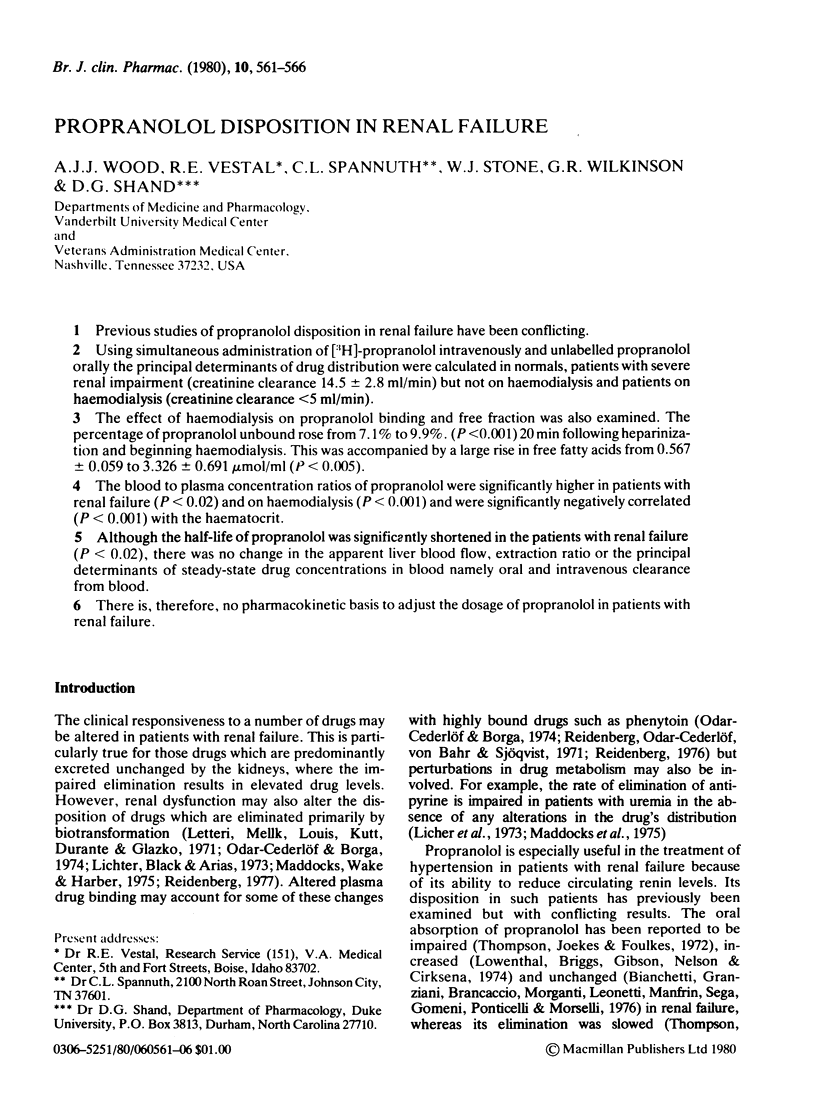
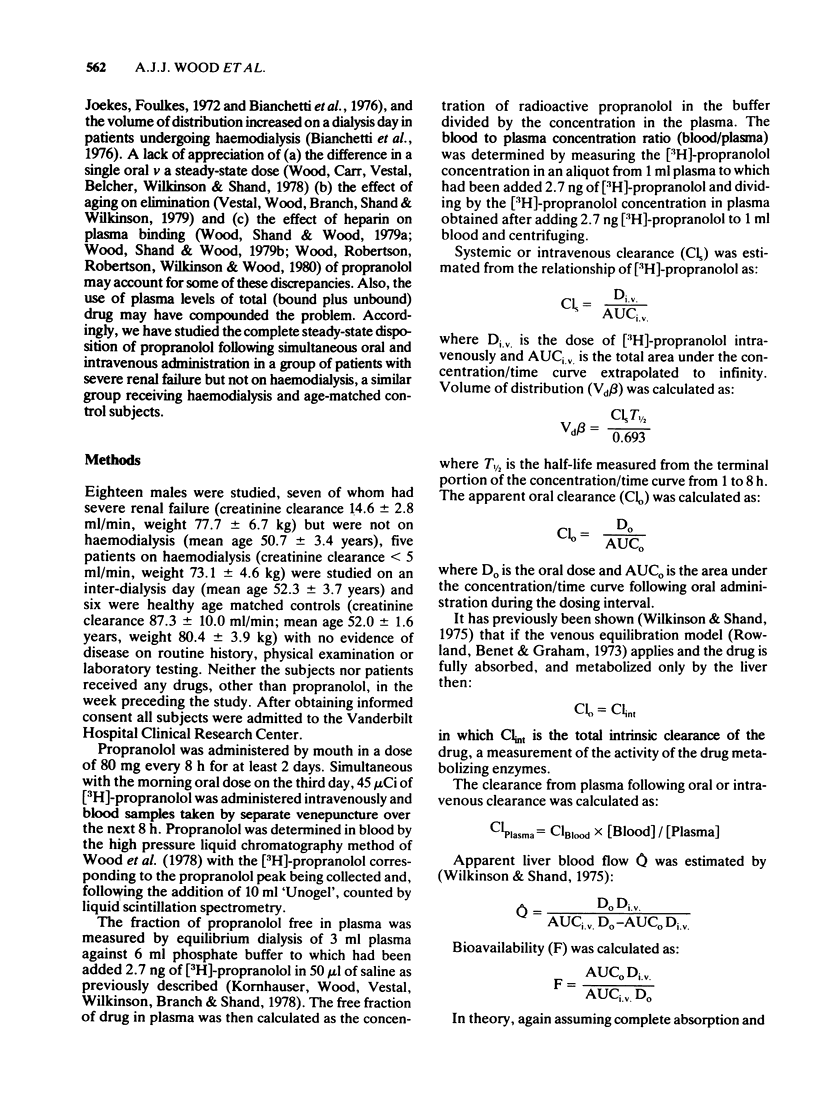
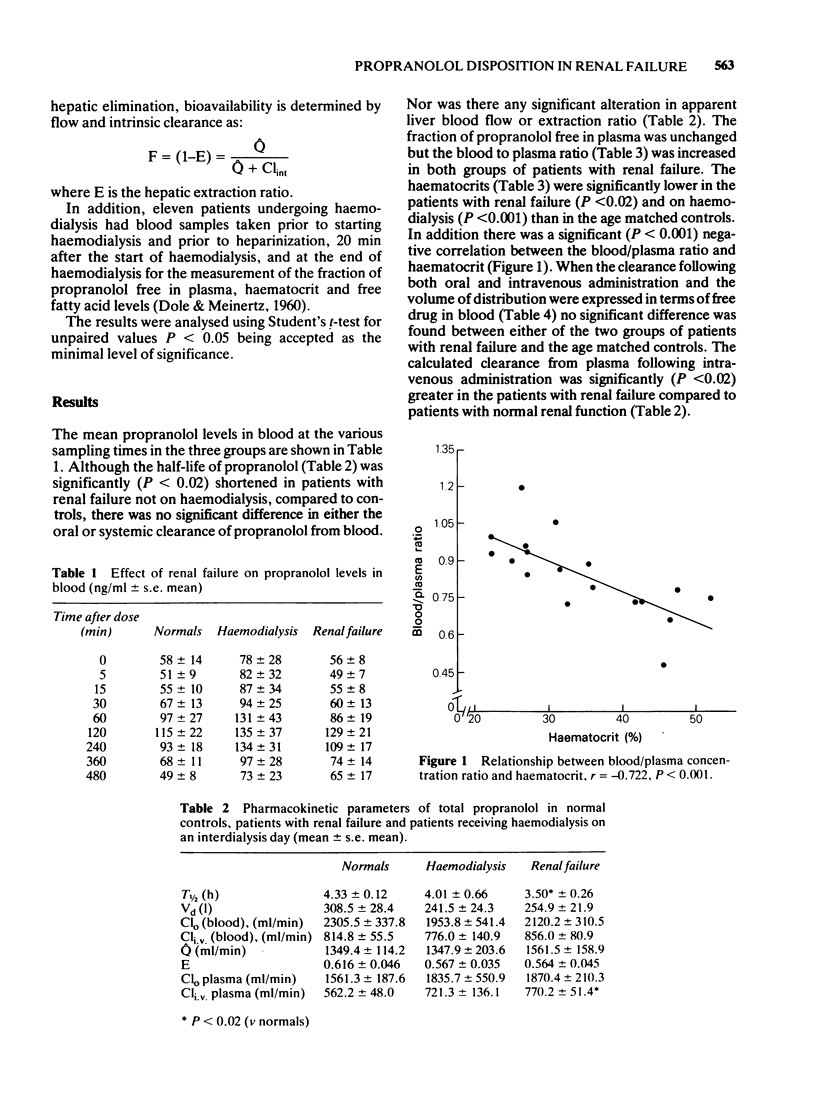
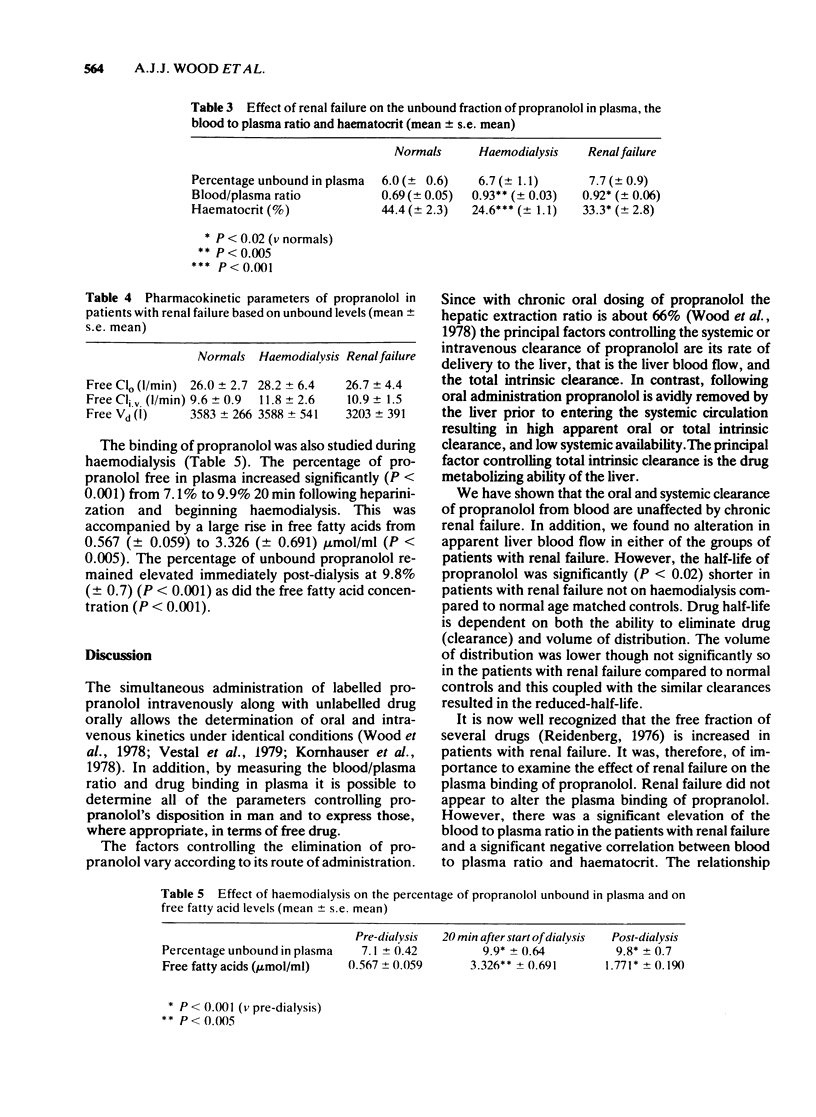
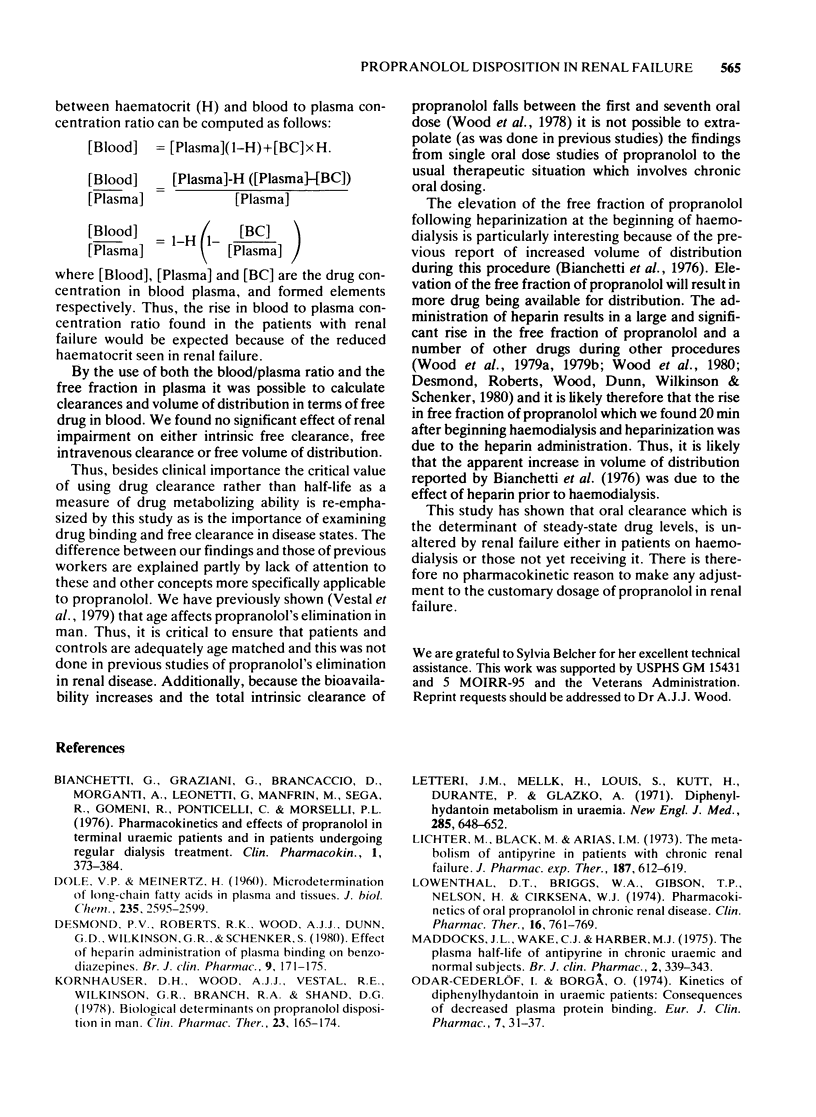
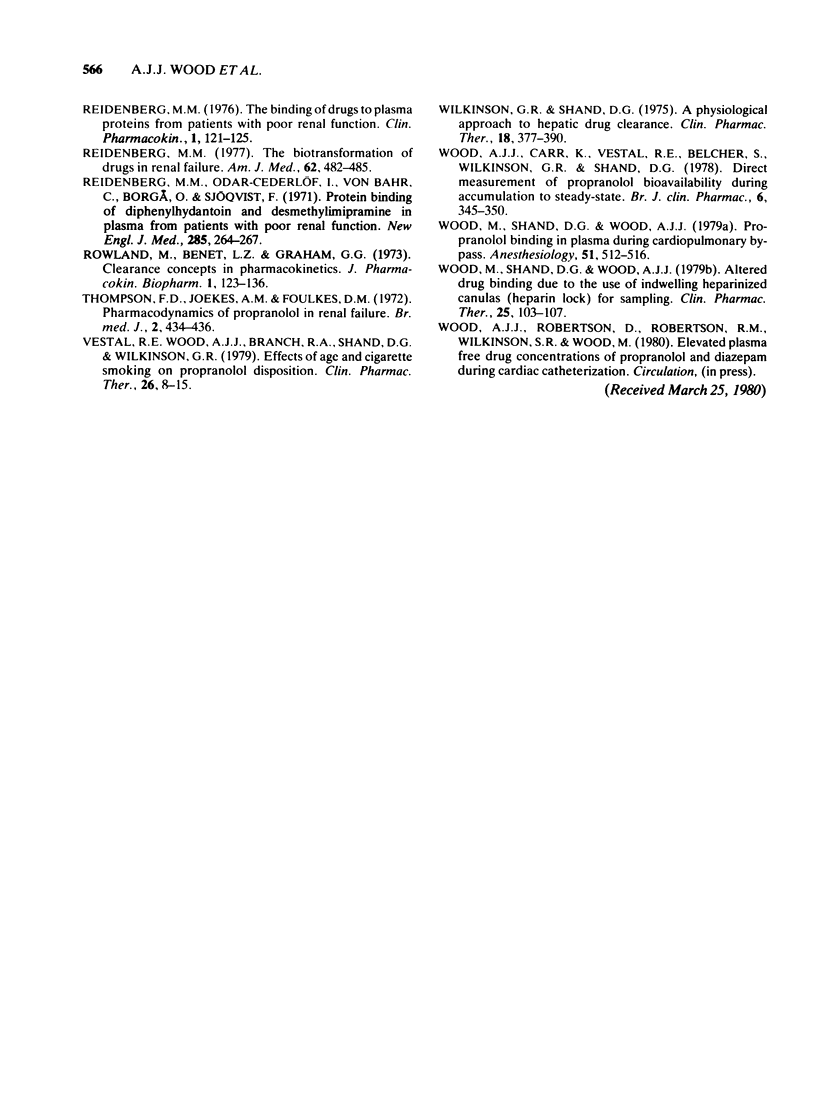
Selected References
These references are in PubMed. This may not be the complete list of references from this article.
- Bianchetti G., Graziani G., Brancaccio D., Morganti A., Leonetti G., Manfrin M., Sega R., Gomeni R., Ponticelli C., Morselli P. L. Pharmacokinetics and effects of propranolol in terminal uraemic patients and in patients undergoing regular dialysis treatment. Clin Pharmacokinet. 1976;1(5):373–384. doi: 10.2165/00003088-197601050-00004. [DOI] [PubMed] [Google Scholar]
- DOLE V. P., MEINERTZ H. Microdetermination of long-chain fatty acids in plasma and tissues. J Biol Chem. 1960 Sep;235:2595–2599. [PubMed] [Google Scholar]
- Desmond P. V., Roberts R. K., Wood A. J., Dunn G. D., Wilkinson G. R., Schenker S. Effect of heparin administration on plasma binding of benzodiazepines. Br J Clin Pharmacol. 1980 Feb;9(2):171–175. doi: 10.1111/j.1365-2125.1980.tb05829.x. [DOI] [PMC free article] [PubMed] [Google Scholar]
- Kornhauser D. M., Wood A. J., Vestal R. E., Wilkinson G. R., Branch R. A., Shand D. G. Biological determinants of propranolol disposition in man. Clin Pharmacol Ther. 1978 Feb;23(2):165–174. doi: 10.1002/cpt1978232165. [DOI] [PubMed] [Google Scholar]
- Letteri J. M., Mellk H., Louis S., Kutt H., Durante P., Glazko A. Diphenylhydantoin metabolism in uremia. N Engl J Med. 1971 Sep 16;285(12):648–652. doi: 10.1056/NEJM197109162851202. [DOI] [PubMed] [Google Scholar]
- Lichter M., Black M., Arias I. M. The metabolism of antipyrine in patients with chronic renal failure. J Pharmacol Exp Ther. 1973 Dec;187(3):612–619. [PubMed] [Google Scholar]
- Lowenthal D. T., Briggs W. A., Gibson T. P., Nelson H., Cirksena W. J. Pharmacokinetics of oral propranolol in chronic renal disease. Clin Pharmacol Ther. 1974 Nov;16(5 Pt 1):761–769. doi: 10.1002/cpt1974165part1761. [DOI] [PubMed] [Google Scholar]
- Maddocks J. L., Wake C. J., Harber M. J. The plasma half-life of antipyrine in chromic uraemic and normal subjects. Br J Clin Pharmacol. 1975 Aug;2(4):339–343. doi: 10.1111/j.1365-2125.1975.tb02781.x. [DOI] [PMC free article] [PubMed] [Google Scholar]
- Odar-Cederlöf I., Borgå O. Kinetics of diphenylhydantoin in uraemic patients: consequences of decreased plasma protein binding. Eur J Clin Pharmacol. 1974;7(1):31–37. doi: 10.1007/BF00614387. [DOI] [PubMed] [Google Scholar]
- Reidenberg M. M., Odar-Cederlöf I., von Bahr C., Borgå O., Sjöqvist F. Protein binding of diphenylhydantoin and desmethylimipramine in plasma from patients with poor renal function. N Engl J Med. 1971 Jul 29;285(5):264–267. doi: 10.1056/NEJM197107292850506. [DOI] [PubMed] [Google Scholar]
- Reidenberg M. M. The binding of drugs to plasma proteins from patients with poor renal function. Clin Pharmacokinet. 1976;1(2):121–125. doi: 10.2165/00003088-197601020-00003. [DOI] [PubMed] [Google Scholar]
- Reidenberg M. M. The biotransformation of drugs in renal failure. Am J Med. 1977 Apr;62(4):482–485. doi: 10.1016/0002-9343(77)90401-6. [DOI] [PubMed] [Google Scholar]
- Rowland M., Benet L. Z., Graham G. G. Clearance concepts in pharmacokinetics. J Pharmacokinet Biopharm. 1973 Apr;1(2):123–136. doi: 10.1007/BF01059626. [DOI] [PubMed] [Google Scholar]
- Thompson F. D., Joekes A. M., Foulkes D. M. Pharmacodynamics of propranolol in renal failure. Br Med J. 1972 May 20;2(5811):434–436. doi: 10.1136/bmj.2.5811.434. [DOI] [PMC free article] [PubMed] [Google Scholar]
- Vestal R. E., Wood A. J., Branch R. A., Shand D. G., Wilkinson G. R. Effects of age and cigarette smoking on propranolol disposition. Clin Pharmacol Ther. 1979 Jul;26(1):8–15. doi: 10.1002/cpt19792618. [DOI] [PubMed] [Google Scholar]
- Wilkinson G. R., Shand D. G. Commentary: a physiological approach to hepatic drug clearance. Clin Pharmacol Ther. 1975 Oct;18(4):377–390. doi: 10.1002/cpt1975184377. [DOI] [PubMed] [Google Scholar]
- Wood A. J., Carr K., Vestal R. E., Belcher S., Wilkinson G. R., Shand D. G. Direct measurement of propranolol bioavailability during accumulation to steady-state. Br J Clin Pharmacol. 1978 Oct;6(4):345–350. doi: 10.1111/j.1365-2125.1978.tb00862.x. [DOI] [PMC free article] [PubMed] [Google Scholar]
- Wood M., Shand D. G., Wood A. J. Altered drug binding due to the use of indwelling heparinized cannulas (heparin lock) for sampling. Clin Pharmacol Ther. 1979 Jan;25(1):103–107. doi: 10.1002/cpt1979251103. [DOI] [PubMed] [Google Scholar]
- Wood M., Shand D. G., Wood A. J. Propranolol binding in plasma during cardiopulmonary bypass. Anesthesiology. 1979 Dec;51(6):512–516. doi: 10.1097/00000542-197912000-00006. [DOI] [PubMed] [Google Scholar]


